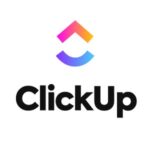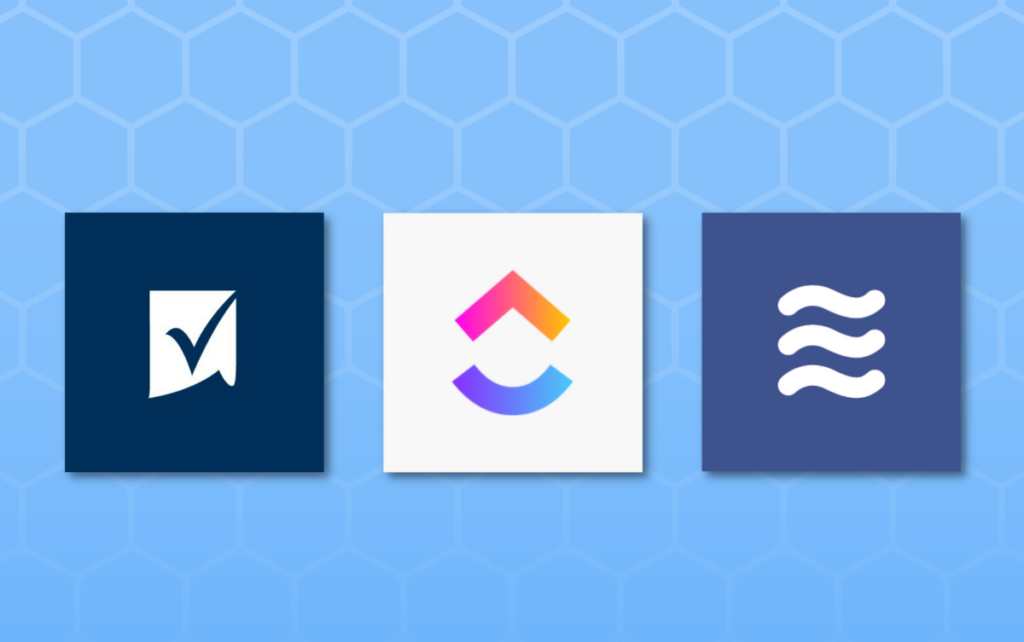Smartsheet and ClickUp are two project management companies you will undoubtedly come across in your search for project management software. Teams often compare these two software platforms because they both have a large user base and somewhat similar features. However, their features are much more unique than they are similar once you really get into your research. Let’s review the similarities and differences in features and functionality between Smartsheet and ClickUp so you can better understand which platform may be a better option for your organization’s unique needs.
What is Smartsheet?
Smartsheet is a cloud-based project management platform that is known for empowering companies to plan, execute, and report on projects. Smartsheet uses a very similar layout and style to Excel workbooks to make it easy for customers to get started with their planning needs. Smartsheet translates an organization’s vision into practical project plans by aligning strategic objectives with priorities. This flexible, on-demand tool highlights automated reporting and effective data analysis to enable teams to eliminate inefficiencies.
What is ClickUp?
ClickUp is a robust multi-functional productivity platform created to help teams plan, organize and collaborate more efficiently. ClickUp boasts numerous application integrations to connect all your favorite apps into one productivity platform. This allows you to integrate and customize your experience with just a few clicks. ClickUp is unique because it has hundreds of automations to help teams easily assign tasks, comment on projects, update statuses, and connect with other tools. ClickUp can be a fit for organizations of all sizes and industries to collaborate more effectively.
Now let’s dive into the most important project management features to see which tool is best suited for your organization’s unique needs.
ClickUp vs. Smartsheet vs. LiquidPlanner Features
Now let’s dive into the details on exactly how these software solutions compare to each other in some of the most important categories:
- Reporting & Insights
- Time Management
- Portfolio Management
- Predictive Scheduling
- Workflow Management
Reporting & Insights
The project management software you choose should have robust reporting and insights capabilities. This is critical to help give you the insights you need as a project leader to ensure your projects are on track and staying within budget.
Smartsheet and ClickUp both allow customization of various dashboard views so users can choose which items and information are most important to their workflow. Both platforms also allow you to customize various templates, so you can see real-time insights quickly.
Both platforms also offer an open API and many integrations to connect organizations’ most used apps into one robust platform. This feature is especially useful for connecting various data sources to have a single source of reporting.
ClickUp’s unique feature is its robust level of integrations. The inclusion of social media integrations is the most unique to other project management tools to make reporting on social metrics even more easy for marketing managers. ClickUp boasts more than 1,000 integrations.
LiquidPlanner stands out from these two project management software options with its integrated risk alerts. The schedule risk alerts visually show you when a project or task is expected to complete after the target finish date. This level of insight is unique to LiquidPlanner and allows teams to troubleshoot bottlenecks, resource allocation issues, and more before deadlines are missed.
 Smartsheet |  ClickUp |  LiquidPlanner | |
| Real-time Reporting |  |  |  |
| Customizable Dashboards |  |  |  |
| Open API |  |  |  |
| Agile Dashboards |  |  | |
| Risk Management |  |
Time Management
Time management is another essential feature for a robust project management platform. There are two primary components to time management: time tracking and estimation. Tracking time is critical to see how much time is spent on each project and task. But estimation is an often overlooked strategic component to project management. Let’s dive into how these features compare for Smartsheet and ClickUp.
Both Smartsheet and ClickUp have time-tracking capabilities, but you need to subscribe to Resource Management by Smartsheet to access the full-suite time-tracking features. This makes Smartsheet’s time-tracking capabilities much more cumbersome than other time management apps because it creates a disjointed workflow process. You’ll need to take two extra steps to connect the two platforms together in Smartsheet.
ClickUp, however, has the time tracking feature integrated into it’s app. This makes the ClickUp platform much simpler to use to track time compared to Smartsheet. ClickUp can also integrate with other apps that you may track time in for a one stop shop approach. Smartsheet also has limited time estimation capabilities, which makes ClickUp the clear winner between these two for time management.
However, LiquidPlanner’s methodology for time estimation far exceeds Smartsheet and ClickUp. LiquidPlanner uses a ranged estimation to predict project schedules more accurately. By using a best-case to worst-case scenario for each task that rolls up into the project timeline, you can be much more confident in your time estimations by capturing this inherent uncertainty in project planning. This methodology creates a project timeline that is much more accurate from the start of the project.
 Smartsheet |  ClickUp |  LiquidPlanner | |
| Timesheet Export |  |  |  |
| Billable & Non-Billable Hours |  |  |  |
| Custom Cost Codes |  |  | |
| Integrated Timer |  | ||
| Ranged Estimation |  |
Portfolio Management
Portfolio management is essential for any organizations who share resources between disparate teams. In order to most efficiently schedule resources, your project management software needs to take the entire portfolio into account. Portfolio management is also essential when organizations face multiple competing priorities between teams to manage the prioritization of organizational-wide tasks effectively. Leadership should also be able to scenario plan adding new projects, resources, or timelines to see how shifting one project affects the entire portfolio. Let’s see how each of these features compares to one another.
Smartsheet provides a portfolio approach by encouraging alignment to the organization’s strategy by connecting back to task execution. Smartsheet is better designed for enterprise-level organizations than ClickUp, which performs better in the small to medium-sized categories. Both Smartsheet and ClickUp have all of the main features needed for effective portfolio management except one key strategic component: scenario planning.
LiquidPlanner stands out in its project portfolio management features because of its robust capabilities to what-if scenario plan many things, including changing priorities, adding new projects or resources, reducing resources, and much more. Their complex Monte Carlo simulation runs across all tasks and projects in your entire portfolio with every change to update project timelines in real-time. If you need software that includes the ability to gain these strategic insights, you may want to consider LiquidPlanner over Smartsheet and ClickUp.
 Smartsheet |  ClickUp |  LiquidPlanner | |
| Org-Wide Performance Dashboards |  |  |  |
| Resource Allocation |  |  |  |
| Enterprise Pricing Available |  |  |  |
| Project Prioritization |  |  |  |
| Scenario Planning |  |
Project Scheduling
Project scheduling is another essential feature of project management software. Project leaders need to be able to see a project’s schedule and how each individual resource (human and machine) is affecting the project timeline. So let’s see how these project scheduling features compare.
Both Smartsheet and ClickUp have all of the essential project scheduling components needed to manage projects effectively. Smartsheet and ClickUp both utilize Gantt charts and Kanban boards to visualize project progress and can utilize milestones. They also both utilize a calendar view to also visualize project completion dates and milestones. However, ClickUp’s functionality is the clear winner compared to Smartsheet. ClickUp makes it easier to customize your project’s status. Plus, you can change many tasks at once with bulk editing and scheduling.
But LiquidPlanner has two features that stand out against Smartsheet and ClickUp: its predictive scheduling engine and deadline risk alerts.
Their predictive scheduling engine helps you more accurately forecast your project timeline by including best-case and worst-case ranges. This methodology predicts a project’s finish date with 90% confidence. Other software companies only let you input a single time estimate which is often miscalculated. This is why so many companies end up finishing projects later than expected.
LiquidPlanner also shows you if any tasks or resources are bottlenecks in your project schedule. This allows you to balance the team’s workload and shift priorities to avoid a missed deadline before it happens. Risk alerts is a key feature you need to manage project schedules effectively.
 Smartsheet |  ClickUp |  LiquidPlanner | |
| Critical Path |  |  |  |
| Custom Task Status |  |  | |
| Bulk Scheduling |  |  | |
| Predictive Scheduling |  | ||
| Schedule Risk |  |
Workflow Management
Workflow management is an essential feature if you are also managing resources for a project. Sometimes resource management is controlled by other departments, but oftentimes, project managers need to take on this role themselves. When this happens, you need an integrated resource and project management solution that can incorporate both into a seamless workflow. Let’s see how these key features compare.
Smartsheet and ClickUp both support tracking dependencies between tasks, projects, and resources. Both also have a simple yet powerful automated workflow system and allow you to standardize processes with templates to automate project creation and reporting. But you will need to subscribe to Smartsheet’s Resource Management product in order to have these workflow management features.
Smartsheet and ClickUp both boast numerous automations to eliminate time spent on repetitive tasks. Smartsheet allows you to set up recurring or condition-based workflows that run at time-specific intervals or automatically. ClickUp’s Whiteboard feature helps you create workflows for simple collaboration and share as they need it. Smartsheet appears to be the clear winner between these two options, despite the extra steps needed to connect two of their systems together.
One feature that LiquidPlanner has that Smartsheet and ClickUp do not have is automatic resource-leveling. Smartsheet and ClickUp both do have resource leveling components, but not to the level of LiquidPlanner. LiquidPlanner is unique because it optimizes the schedule based on organization-wide constraints and prioritization. This unique feature stops individuals and resources from being overloaded with work. Any available gaps will be automatically filled with lower-priority work. Plus, predictive scheduling helps teams to include the inherent uncertainty in project planning through a complex simulation to predict schedules with 90% confidence.
 Smartsheet |  ClickUp |  LiquidPlanner | |
| Automate Workflows |  |  |  |
| Standardized Templates |  |  |  |
| Third-Party Integrations |  |  |  |
| Dependency Tracking |  |  |  |
| Automatic Resource Leveling |  |
ClickUp Pricing

ClickUp has five different pricing options. ClickUp has a free plan option to get you started. Their Unlimited plan is $5 per user per month which includes more lists, spaces, whiteboards, automations, and custom fields. Paid plans also allow guests to view the workspace. Their Business plan is $12 user month which includes unlimited timelines, activity, workloads, and whiteboards. The max automations increase to 10,000 and along with more sub-tasks. Their Business Plus plan is $19 per user per month which includes more customizations, 25,000 automations, more API calls, and unlimited subtasks. Their Enterprise plan boasts the most features with nearly unlimited access across all features but pricing is only available via a call with the sales team. Pricing changes if you pay yearly instead of monthly.
Smartsheet Pricing

Smartsheet offers three plan tiers with no free plan option. Their Pro plan starts at $9 per user per month which includes unlimited sheets, viewers, 10 paid editors, 250 automations, and limited integrations. Their Business plan starts at $32 per user per month which includes unlimited editors, automations, 1TB document storage and much more. Their most robust plan called Enterprise also has an unlisted price – you can call their sales team for details. This plan includes single sign-on, unlimited storage, WorkApps, insights, and much more. Smartsheet also offers a discount when paying yearly instead of monthly.
ClickUp vs Smartsheet Pricing Comparison
 Smartsheet |  ClickUp |  LiquidPlanner | |
| Free Plan Option |  |  |  |
| Free Trial Available |  |  |  |
| Starting Monthly Price Point | $9/user | $0/user | $0/user |
| Business Plan Pricing | $25/user | $19-29/user | $25/user |
| Enterprise Pricing | Call for pricing | Call for pricing | $35/user or less |
Pro's and Con's of Smartsheet vs ClickUp vs LiquidPlanner

Pros and Cons of Using Smartsheet
Smartsheet has less features compared to ClickUp and LiquidPlanner. But it can be perfect for teams who don’t manage complex projects with lots of interdependencies. If you’re looking for an easily adoptable PM solution with a spreadsheet visualization approach, this may be your organization’s tool.
Pros for Smartsheet:
- Recognizable interface, similar to Excel to help get you started quickly
- Simpler platform for less complex project teams
- More workflow management features
Cons to using Smartsheet:
- No free plan option
- More expensive plans overall
- Resource & time management features are add-on services
- Less customization options

Pros and Cons of Using ClickUp
ClickUp’s features are better suited for agile focused teams. ClickUp allows more customizations, such as creating customized funnels to manage sprints better, build Scrum charts, and track issues. Our research shoes that the project management software is less efficient for large enterprise companies.
Pros to ClickUp:
- More affordable monthly price points with more options
- More than 1,000 integrations
- Robust time tracking capabilities
- More dashboards available
- Better project scheduling features
- Easier to customize
Cons to using ClickUp:
- Less efficient for large enterprise organizations
- Paid add-on features
- Less resource management and workflow features

Pros and Cons of Using LiquidPlanner
LiquidPlanner is a unique project management platform. It serves teams managing complex projects with many organization-wide dependencies. LiquidPlanner is ideal for professional services, engineering, manufacturing, and other companies managing competing priorities between teams.
LiquidPlanner Pros:
- Robust time estimation features
- Predictive scheduling engine to create timelines
- Automatic resource leveling
- Integrated risk alerts to prevent missed deadlines
- Ability to scenario plan quickly and easily
- Includes a portfolio level view of all projects, resources, and risks
- No add-on feature pricing
LiquidPlanner Cons:
- No integrated time tracker
- Fewer integrations and automations
- Less customization options than ClickUp
Closing Summary on Smartsheet vs. Clickup
All three products outlined today are well-suited for very different needs depending on the company’s industry and problems they are looking to solve. Not all of these features are needed for each organization, so you must take the time to understand the ‘nice to haves’ from the necessities. It’s also important to understand and communicate how these features will impact various teams across the organization. It’s much easier to get project buy-in if you can showcase how the project management software will impact each individual team and resource.







